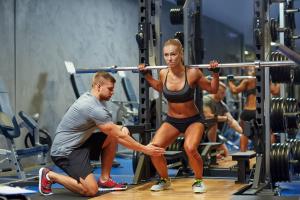The Brookbush Institute updates 'Hip Anatomy and Squat Form'
Research debunks the myth that "unique hip anatomy" affects squat foot placement. Find out why hip anatomy likely has nothing to do with squat technique.
- Additional Resources: Femoral Anteversion
- Included in the course "Lower Body Exercise Progressions" and credits toward the Certified Personal Trainer (CPT) Certification
INTRODUCTION
Modifying foot position or stance width during a barbell squat to accommodate "unique hip anatomy" is a questionable approach for several reasons. For example, the majority of individuals have similar proportional anatomy. Further, it is a logical leap to imply changes in hip joint structure should alter foot position, bypassing the knee and ankle joint completely. Additionally, why not first address other potential contributing factors, such as mobility limitations (e.g., restricted knee flexion, hip rotation, or ankle dorsiflexion), altered muscle activity (e.g., gluteus medius or tibialis anterior activation), or weaknesses in the primary muscles involved (e.g., gluteus maximus, quadriceps, or soleus)? Note that this reasoning applies to a wide range of lower-extremity strength exercises, including variations of the back squat (e.g., high bar and low bar), leg press, hack squat, Smith machine squat, as well as lunges, split squats, and step-ups.
BROOKBUSH INSTITUTE'S POSITION STATEMENT
Research demonstrates that the number of individuals exhibiting significant hip structure differences is relatively small (less than 10%). Further, for the few individuals who exhibit significantly different hip morphology, there is no evidence to suggest that changing foot position during a squat will increase performance or decrease the risk of injury. Research also suggests that changes in mobility and muscle activity are correlated with an inability to maintain optimal alignment or perform a full range of motion during lower extremity exercises with toes forward and feet hip-to-shoulder-width apart. Discomfort when performing lower extremity exercises should not be considered evidence of a structural issue and instead should be considered an opportunity to address mobility or muscle activity issues with manual therapy and/or corrective exercise techniques, with the potential to significantly improve performance.
SUMMARY OF THE ISSUES WITH CORRELATING HIP ANATOMY AND FOOT POSITION
- Normally Distributed: Research suggests that variations in hip anatomy are normally distributed and could be plotted on a "bell curve.” That is, the gross majority of individuals exhibit bone shape, angles, and alignment that are within a relatively small range of variation.
Little to No Correlation: There may be no correlation between hip morphology and foot placement. In fact, it is likely that other structural angles compensate for normal variations in hip morphology during development.
- A Logical Error: Excessive hip retroversion and excessive hip anteversion cannot both be addressed by the same recommendation (feet wider and/or feet turned out). Further, if the standard deviation in hip anteversion is about 10°, how does anyone justify 20 - 50° of feet turn out during squats?
- A Functional Anatomy Error: Feet turn out is not hip external rotation; it is tibia (knee) external rotation.
- Correlated with Pain, Dysfunction, and Injury: Knee pain is correlated with less hip and knee internal rotation ROM, more knee varus, and more tibia and foot external rotation during a variety of activities. This implies that the recommendation to turn the feet out and/or "drive" the knees into varus (knees bow out) may contribute to an increased risk of pain and dysfunction.
- A Better Solution: Before accepting small imperfections in movement as evidence of permanent structural differences, it is recommended that these issues (e.g., feet turn out, knees bow in, etc.) are treated as soft-tissue issues and targeted with an "integrated manual therapy," "corrective exercise," or "movement prep" routine.
For an in-depth review and all available research on this topic, please visit the full article via the links above.
Brent Brookbush
Brookbush Institute
Support@BrookbushInstitute.com
Visit us on social media:
Facebook
X
LinkedIn
Instagram
YouTube
TikTok
Other
Legal Disclaimer:
EIN Presswire provides this news content "as is" without warranty of any kind. We do not accept any responsibility or liability for the accuracy, content, images, videos, licenses, completeness, legality, or reliability of the information contained in this article. If you have any complaints or copyright issues related to this article, kindly contact the author above.

